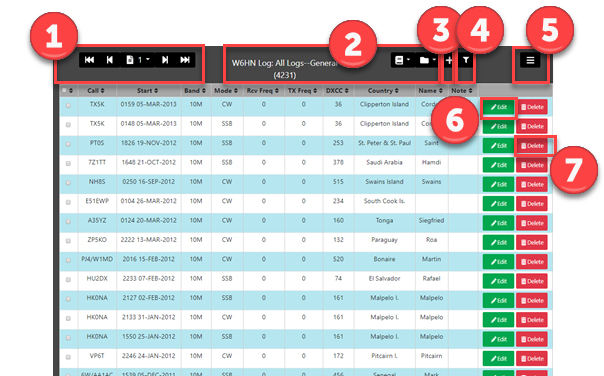
1: Navigating
Use the Log navigation bar at the top left of the log under the RSS navigation bar to move from page-to-page. Up to 25 QSOs are shown on each page. Navigate to any page in your log using the drop-down page list.
2: Log Name and Log style
Each log has a name and a style. By using distinct names you can maintain separate logs, such as for contests or different accounts.
The name and style are shown at the center of the Log navigation bar. The number after the style shows the number of contacts for that log.
Each log has its own style appropriate for its use. A log can be designed for any purpose, such as Field Day, a DX contest, or for general use. Use the Log Designer (SETTINGS>Log Designer) to design or modify the fields and field order that appear in each log.
The log style can be changed to a different style from the Style (book icon) button. The Log can be selected from the Log (folder icon) button.
Log styles are created and edited in the Log Designer window. Accounts can share logs and log styles.
3: Add a new Contact
Click the + (plus) button to add a contact to the current Log. The Log Editor window opens where you can add details for the contact and load information from the Callbook Lookup. See the Log Editor topic for details.
4: Filtering QSO's
Click the filter (funnel icon) button to show contacts matching the call in the Callbook lookup box in the top right of the RSS navigation bar. Click the filter button again to show all contacts.
5: Export/Import ADIF
Amateur Data Interchange Format (ADIF) is the data import/export standard for amateur radio logs. It allows logbook data to be easily transferred from one program to another. ADIF is also the basis for submission of logs to the ARRL Logbook of the World (LoTW) and other online logging systems. All downloads compress the ADIF file to the ZIP format. Export transfers the ADIF from RSS to the local downloads folder usually on another computer. Import transfers an ADIF file to RSS.
Export to Downloads Folder
Download all QSO's in the current log to the Downloads folder. If using RigPi from the RSS Desktop, the Downloads folder is the one for RSS. If connecting to RSS from a remote computer, the Downloads folder for that computer is used.
The file is given a name like rigpi<YOURCALL><Logname>-<n>.zip. For example, a file containing my Mobile log would be named rigpiW6HNMobile.zip (first download) or rigpiW6HNMobile-1.zip (second download).
To download all QSO's from all logs, select the ALL Logs option from the Log list (folder icon).
Export Selected Q's
Download the selected QSO's. To select QSO's the Select column must appear in the Log. The Select column can be added using the Log Designer opened from SETTINGS>Log Designer.
Export for LoTW
Download all QSO's in the current log with a subset of fields appropriate for LoTW.
Export Selected Q's for LoTW
Download selected QSO's in the current log using a subset of fields appropriate for LoTW.
Import
Upload files must not be compressed and have an extension .adi. For example, my upload file might be named W6HN-11-12-2018.adi. RigPi asks you to identify the file you wish to upload. RigPi then proceeds to import the adi file into the currently open logbook.
6: Editing an Existing Contact
Click the Edit button on the left end of a logged contact to open the Log Editor for that contact. See the Log Editor topic for details.
7: Delete Contacts
Click the Delete button on the right end of a QSO line to delete that contact.
Entire Log
In the drop-down menu, deletes all contacts from the currently open log. If ALL Logs is selected, all QSO's are deleted from all logs.
Selected Q's
In the drop-down menu, deletes the selected QSO's from the currently open log. To select QSO's the Select column must appear in the Log. The Select column can be added using the Log Designer opened from SETTINGS>Log Designer.
Sorting Contacts
Click the Up/Down arrowhead in a column header to sort the log by that column. Click again to sort in the opposite direction. To return to date order, click the Start header.